Lunch with Lynne: Savory Squash Pie

Before cooking from The Food and Wine of Greece by Diane Kochilas, I had no idea how diverse the savory pitta options are in Greek cooking—pitta is the Greek word for “pie.” Like many Americans, I’ve eaten and enjoyed Spanakopitta, the popular Greek pie made with spinach (spanaki) and cheese and layers of super thin phyllo dough. But there are many more savory pies: lamb, zucchini and cornmeal, ground beef with a rich béchamel sauce, leeks, wild greens, artichokes, rabbit. During the several weeks the club has been cooking from The Food and Wine of Greece, I made Hirinopitta (Ground Pork Pie) (see photo), Kotopitta me Feta (Chicken and Feta Pie), and, for lunch with Lynne, Kolokithopitta (Savory Squash Pie), shown above. (A slightly different version of the recipe for the squash filling and pie dough can be found on Diane Kochilas’s website.)
Phyllo means “leaf” in Greek, describing the very thin sheets the dough is sometimes rolled into. In her later book, The Greek Vegetarian, Kochilas describes how experienced Greek cooks “open”—the idiom for rolling out dough—“sheet after gossamer sheet” of dough. (“Gossamer” stops me dead in my tracks.)
I made the Ground Pork Pie with store-bought phyllo dough, not even considering that homemade phyllo is something mere mortals, or non-Greeks like myself, ought to attempt without fear. Yet it is, if one is making the type of rustic, almost bulky, phyllo dough used in Kochilas’s pitta recipes.
After looking more closely at Kochilas’s recipe for Classic Phyllo Dough I realized that she did not expect me to roll the dough to a leaflike thinness or, for that matter, work with several sheets of dough. Just like an American pie, there would be just two pieces of dough—one for the bottom, and one for the top. I imagine Kochilas encourages home cooks to make homemade phyllo dough precisely because it isn’t daunting. Yet when it comes to the famously flaky, delicate Greek pastries that require super thin sheets of phyllo, such as baklava, she calls for commercial phyllo pastry, apparently knowing the limits and patience of the American home cook.
In Greece, pie fillings are paired with variations on the basic phyllo dough, based on tradition and regional preferences. One of the cool things about making your own phyllo dough is that you can customize it with ouzo, vinegar, yogurt, seltzer, or beer according to the pie you are making. You can even make a whole-wheat version or “Classic Phyllo Dough II,” which uses all-purpose flour instead of bread flour, and vegetable shortening instead of olive oil.
Homemade pitta dough is quite different from the commercial wafer-thin phyllo dough familiar to most Americans. Kochilas’s basic recipe is made with bread flour and is kneaded, giving it a silky smooth and elastic feeling. The result is something akin to pizza dough, or, according to our British friends who tried it, something like the dough used to make Cornish pasties. It’s very filling. Haven eaten this bready phyllo, I can see why these pies are considered a staple in the Greek kitchen, and something to stretch the larder in lean times.
 The last time I aspired to make dough, I solicited the help of my friend Lynne Gately. (We made paratha for an Indian lunch from Entice with Spice.) For our Greek lunch I set her to rolling dough—someone has to take the photographs, right? I’d made the filling during the morning and the dough the night before—it needs to be refrigerated for one hour before using, but can be made up to three days in advance. While the pie baked, Lynne and I relaxed over a cup of coffee and Olive Oil Biscuits with Cumin and Sesame, also from The Food and Wine of Greece. (That’s why Lynne looks so happy in the photo to the left).
The last time I aspired to make dough, I solicited the help of my friend Lynne Gately. (We made paratha for an Indian lunch from Entice with Spice.) For our Greek lunch I set her to rolling dough—someone has to take the photographs, right? I’d made the filling during the morning and the dough the night before—it needs to be refrigerated for one hour before using, but can be made up to three days in advance. While the pie baked, Lynne and I relaxed over a cup of coffee and Olive Oil Biscuits with Cumin and Sesame, also from The Food and Wine of Greece. (That’s why Lynne looks so happy in the photo to the left).
Here is how you work with homemade phyllo dough:
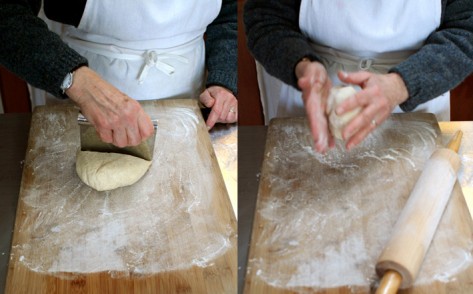
After letting the refrigerated dough set out for about 30 minutes, cut the dough in half. Then, rolling one of the dough halves between your hands, form it into a ball to encourage it to roll into a circle. (The latter is my and Lynne’s idea, which I think is a worthwhile step. When I made the chicken and feta pie later that afternoon, I did not form the dough into a ball after cutting it, and the dough didn’t roll out as perfectly round as Lynne’s.)
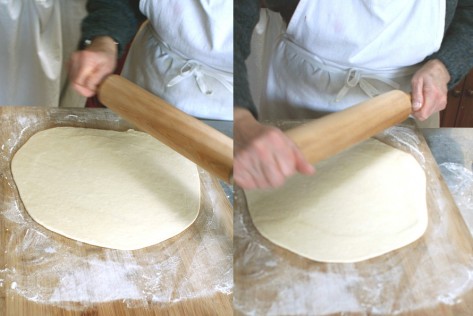
On a lightly floured surface, roll the dough into a diameter about 2 inches larger than the diameter of your pie pan. (Kochilas’s recipe calls for 10½-inch pie pan; I used a 9-inch pie pan.)
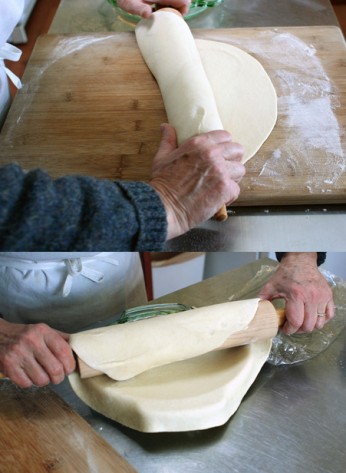
Using the rolling pin, carefully roll the dough up and off the work surface. (This method of picking the dough up is Lynne’s tip—and she says she’s not much of a cook or baker.) Carefully transfer the dough onto a lightly oiled pie pan.

Brush the dough with some olive oil.
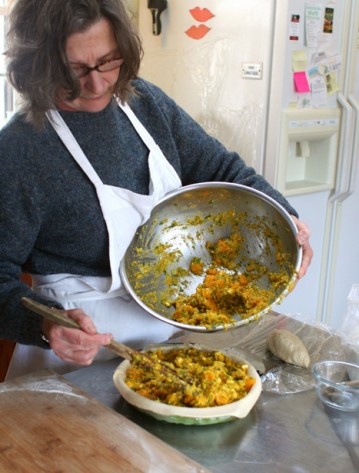
Spread the pie filling over the dough.

Roll out the second piece of dough.
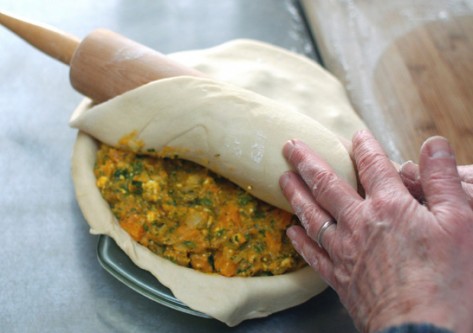
Place the rolled-out dough on top of the pie.
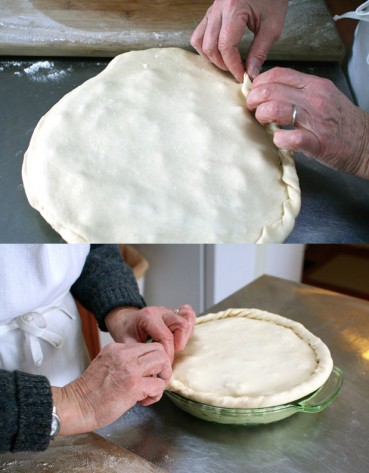
If you have more than an inch hanging over the rim, trim away excess. (We didn’t). Press the top and bottom layers of dough together and begin rolling the edge up and inward to form a thick rim.
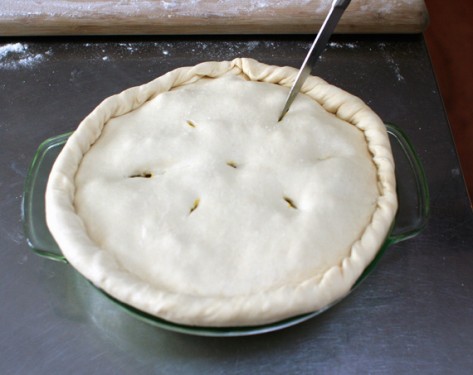
With a sharp knife, make several small incisions in the dough.
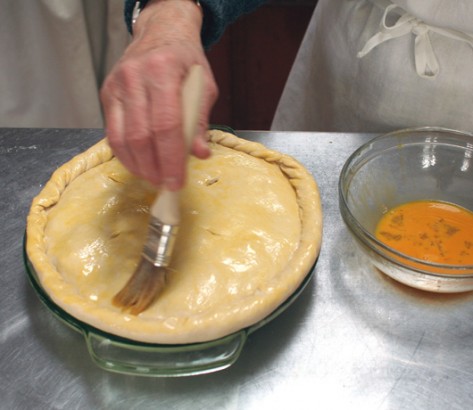
Brush egg yolk on the top before popping the pie in the oven to bake.
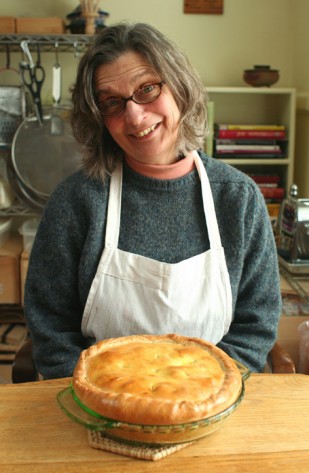
Lynne, with the baked pie. Look how substantial the pie dough is!
